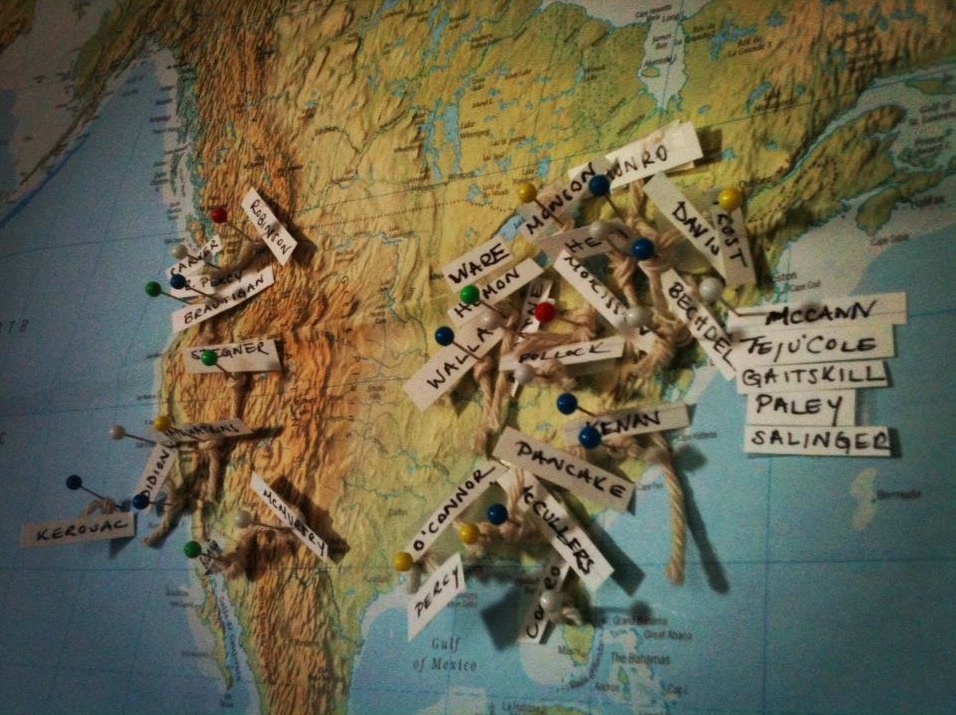View field list: contemporary lit of place & environment in a larger map
Oh hi, viz. readers. I’m Jenn Shapland, a new contributor to the blog. I thought I'd introduce myself by showing you a Google map I made this summer.
It’s a visualization of my field exam reading list. For the last year, I’ve been compiling a list of fiction and nonfiction titles on Contemporary Literature of Place and Environment. My process for developing the list was pretty haphazard at first—I asked just about everyone I knew for suggestions, I Googled like a madwoman, I stood for hours in front of my own bookshelves and BookPeople's, making stacks of possible titles. I started to shelve the books around my house according to geographic region. But, for obvious reasons, it wasn’t long before I realized that I needed a way to see the list in front of me without tripping over it.
To get things a little more organized, I began making maps. Since I started out imagining the list geographically, and since I already had a world map tacked on the wall at home (due to the measliness of my art collection), I grabbed some pins and started labeling. But several authors proved difficult to, uh, pin down. Take, for instance, Jack Kerouac. He’s a pretty important postwar writer of place, but where does he go? He trekked all over the country in his fiction. (As you can see, I ended up stranding him in the Pacific Ocean for the time being. Later on, due to the precision Google mapping requires, I placed him in Washington, atop Desolation Peak.)

Personal photo.
Another challenge of mapping fiction authors? Their penchant for creating fictional towns, cities, or even worlds. Does Colson Whitehead’s Intuitionist take place in New York, even if the city is never named as such? Is it safe to assume that Carson McCullers was writing about a town geographically equivalent to her own home? For these writers, I made my best guess at where their fiction was located. But this wasn’t entirely satisfying. The longer I mapped—and especially as I began to build the map online using Google Maps—the more limited and limiting cartography proved to be.
Place writing fascinates me for this reason. It requires the reader and the writer to move between the external world of their surroundings and the imagined world(s) of their fiction. It makes the conceptual move of the reading process tangible. More on that in my later posts, I’m sure.
As useful as the Google Map was for visually taking in the scope and range of authors on my list, I eventually concluded that topography offered a much better schema for organizing place writing. Literary topography is not exactly a well-known concept—yet—but I aim to make it one. Topography refers to the physical terrain of a given place: its three-dimensional landforms, altitude, and the physical details it encompasses. Topography indicates not only the “natural” elements of a place, but also takes into account the man-made features that exist there. For that reason, even when I enabled the “terrain" feature on Google Maps, I wasn’t seeing what I wanted.
Unlike geographical region, which is often based on old narratives, like the frontier, that no longer apply or tell the whole story; or, environment, which calls for a distinction between what is “natural” and what is “built”; or bioregion, which refers primarily to the natural features present in a given place prior to human interventions and impacts, topography allows a consideration of place as it is, and as people interact with it and experience it. It takes into account the immediate, physical surroundings of a given place. My maps were great, but they didn't give me this kind of depth or nuance.
So, the next step in the process of visualizing my list of place literature is to find a way to capture, to some extent, the aspects of immediate experience. Perhaps photography is the way to go? Or should I build miniature, scale models of these literary terrains? I’m certainly open to suggestions.
Recent comments
2 years 29 weeks ago
2 years 44 weeks ago
2 years 44 weeks ago
2 years 50 weeks ago
3 years 4 weeks ago
3 years 4 weeks ago
3 years 4 weeks ago
3 years 6 weeks ago
3 years 6 weeks ago
3 years 6 weeks ago